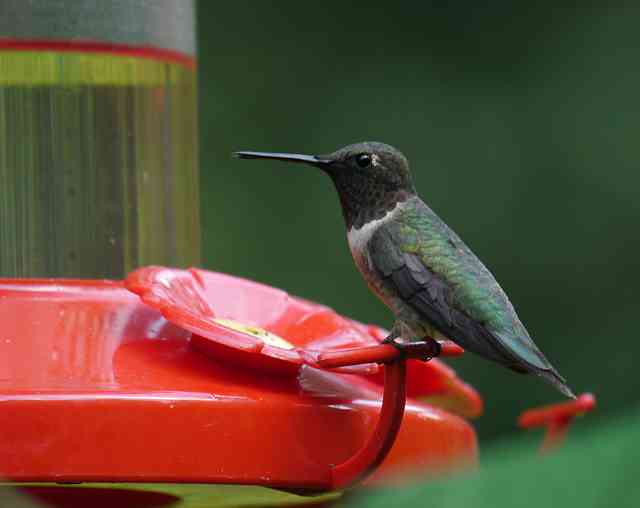Feeding Hummingbirds
Do you want to attract hummingbirds to your yard? You probably won't be as fortunate as the Lancasters, at whose home this video was taken. They apparently live on the "Ruby Throat Superhighway". But you can bring these tiny flying jewels to your yard to admire and enjoy.
Even people who have no particular interest in birds love hummingbirds. Their diminutive size, their feisty nature, and their wonderful colors all inspire admiration. Feeding hummingbirds is one way to bring these tiny, well-camouflaged birds closer to us so we can enjoy them up even more. Some of these suggestions are most applicable for those of us in the Gulf South, but many will apply anywhere.
Here's a link to a presentation on Hummingbirds in Louisiana
Interested in learning more about Winter Hummingbirds in Louisiana? Skip ahead here)
When should I put my feeders up?
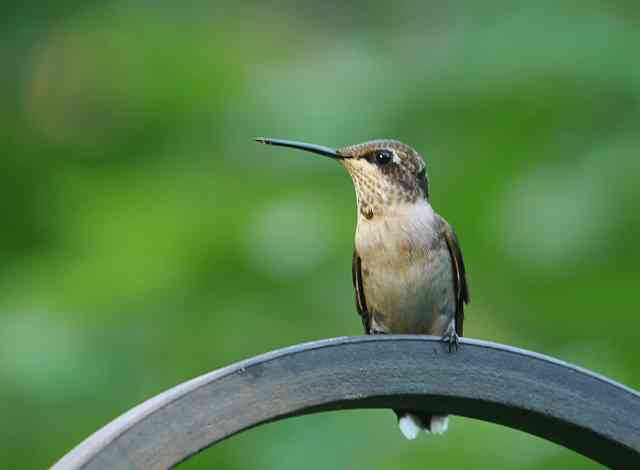
The birds will breed, nest, and raise their young for the next few months. Our feeders will be very quiet from the end of April until about the 4th of July. Then most of the birds are done nesting and they start making their way south. So, put your feeders up in February and you can take it down in October ... unless you want to try to host a "winter" hummingbird (see below).
What kind of feeder should I use?
There are dozens of feeders on the market today. I’ve tried a dozen or so myself and I'm always on the lookout for a new design. I think the most important features to look for are red color, no-drip design, and ease of cleaning. Red is most attractive to hummingbirds. Ironically, many feeders also have yellow on them which attracts bees and wasps that compete for the nectar. It’s best to avoid yellow, if possible.
A feeder that drips will only waste nectar – some styles do a better job with this than others, particularly on windy days. And ease of cleaning is essential. If the feeder is hard to clean you’ll either leave it up too long and the nectar will spoil which may harm the birds, or you won’t put it up at all because it’s too much trouble. Another feature to look for on feeders is a perch. Despite popular belief, hummingbirds do indeed sit still, and you will see them even better if you offer a perch on the feeder so they can sit while they feed.
Feeder recommendation
There are lots of feeders that will attract hummers. It's no accident that most feeders have red on them, as hummers are naturally attracted to red. There are plain feeders, fancy feeders, and everything in between. Some people swear the traditional 4-port Perky Pet Four Fountains feeder attracts the most hummingbirds. Some people claim the saucer shaped Droll Yankee (or something similar) feeders work best.
My recommendation for feeders is the First Nature feeders. They come in two sizes, 16 and 32 ounces. It’s a covered dish type feeder, which doesn’t drip, and seems to deter insects. The base comes apart easily and all parts can be reached for cleaning. The bottle is wide-mouth and plastic, so it’s easy to clean and won’t break if you accidentally drop it or if an animal (like a raccoon) knocks it down. The red color of the base is bright and has no yellow on it. The ports and perches seem to be well placed.
What do I feed the hummingbirds?
The answer is easy, plain table sugar and water. It’s the most similar in chemical content to the natural nectar they get from plants. You can buy packaged nectar mixes, but you’ll just pay more for little value. Mix ¼ cup sugar with each cup of water. I don’t think it’s necessary to boil the water. The idea behind boiling water is to sterilize the solution, but the feeder is likely not sterile and it certainly won’t be once birds start using it. I use hot tap water to dissolve the sugar and then let the mixture cool before using it. Extra nectar can be stored in the refrigerator for a week or so.
You don’t have to fill the feeders to the top! Often you will have more feeders than birds, so it’s fine to just fill the feeder part way. Watch the nectar levels during heavy migration periods – you don’t want the feeders to go empty and the birds to leave after you’ve gone to all this trouble!
Don’t ever use honey or any other type of sweetener to feed hummingbirds.
Doesn't the nectar need to be red?
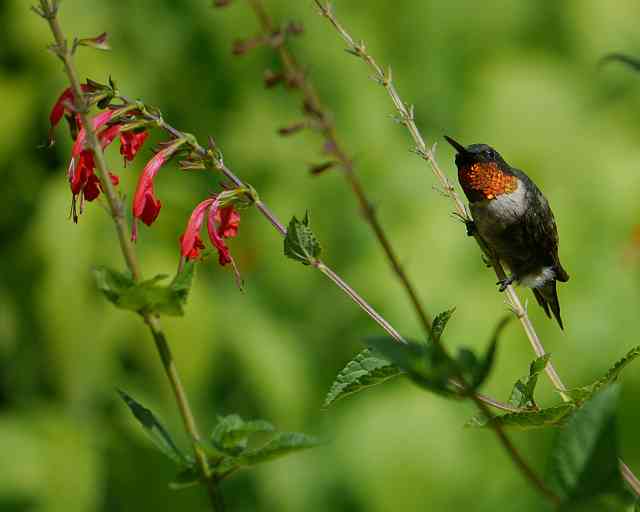
No, no red coloring is needed to attracted hummingbirds. Yes, they will probably drink it, because the main ingredient is sugar and water, just like the stuff you can make for pennies. The store bought stuff costs a lot more than pennies! If you think about it, the nectar they're drinking in nature isn't dyed red...and how would you like most of your food to be colored an unnatural color?? (oh wait, a lot of it is!) As long as the feeder is red or has red parts, it will attract the birds.
How do I clean my feeders?
Discard any unused sugar water. I know it seems wasteful, but you’re only throwing away pennies and spoiled water may harm the birds. Wash the feeder in hot tap water, using your hands or a soft brush. Don’t use any type of detergent or soap. If you see any signs of mold, soak the feeder for 20 minutes in a weak bleach (1/4 c. bleach per gal of water) solution. It’s not even necessary to rinse – chlorine will dissipate rapidly into the air and any other residue breaks down to harmless salts.
How often do I clean my feeders?
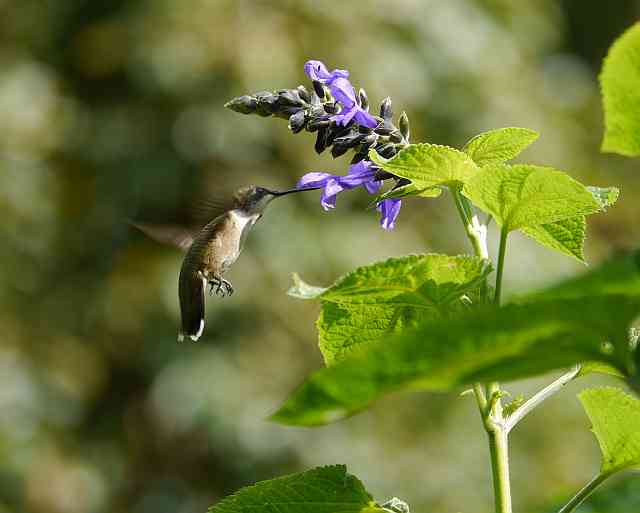
When the solution turns cloudy or you can see black mold, it’s time to discard it and replace it. Generally this might be every 2 to 3 days in the summer and maybe every week in the winter during the cooler weather.
Where should I hang my feeders?
The main reason to hang a hummingbird feeder is so that you can see the birds. It’s not to keep the birds alive – they will do quite well without you, feeding on natural nectar and insects. So put your feeders close to the windows where you’ll be able to see the birds when they visit. A shady spot is best, as the nectar will not spoil as quickly. If you plan to take pictures of the birds at the feeder you will want to consider the natural light – often shooting from indoors to outdoors produces only silhouettes.
Hummers like to guard their feeders, so provide them a place to perch close to the feeder so they can keep an eye on it. Crepe Myrtles are great for this – the thin twigs and branches are a favorite. If you don’t have a natural twig close to the feeder, tie or tape a branch close to the feeder so they can use it as a perch.
How do I keep my hummingbirds from fighting?
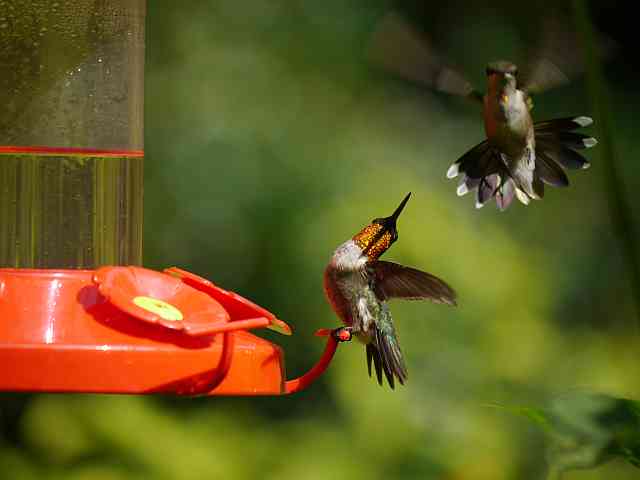
You really can't! Hummingbirds are the most anti-social creatures on earth, I'm convinced! Even their romantic relationships only last a few seconds. Mother hummingbirds care for their chicks for just a couple of weeks and then they're on their own! So don't feel bad if it seems all your birds do is fight -- that's just how they're wired. If you have just a few birds, you can minimize the squabbling by placing feeders out of sight of each other. During very busy periods, they seem to fight a bit less -- concentrating instead on fattening up for their long journey ahead.
What do I do about bees and ants?
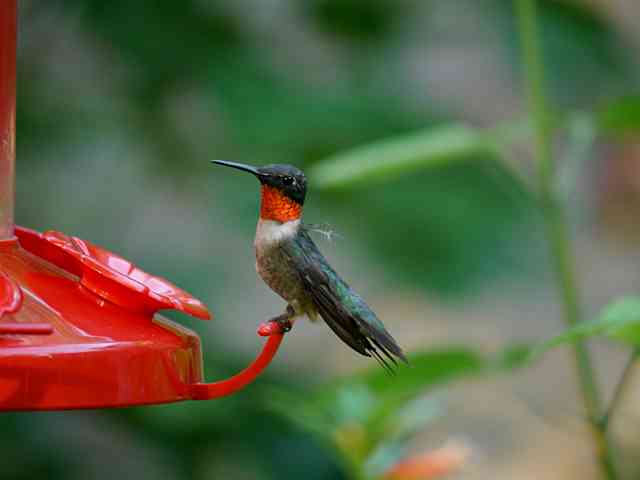
Ants are pretty easy to deal with -- you'll need an antguard. Basically this is cup with hooks on it from which you hang your feeder that has a moat (or possibly a chemical barrier) that prevents the ants from reaching the nectar. You might be able to buy them where feeders are sold, but I usually buy mine online.
Bees and wasps are a little tougher. They can be discouraged by using feeders that won't allow the nectar to reach the edge of the port, or by having bee guards over the ports. The Perky Pet Four Fountain features bee-guards, which ironically are yellow which is more attractive to bees!! Hummingbirds have long bills and tongues -- they can reach down into the port much farther than bees, so if you have a real bee problem using a saucer type feeder usually helps. Bees seem to be more of a problem when they have trouble finding natural nectar sources themselves.
When should I take my feeders down?
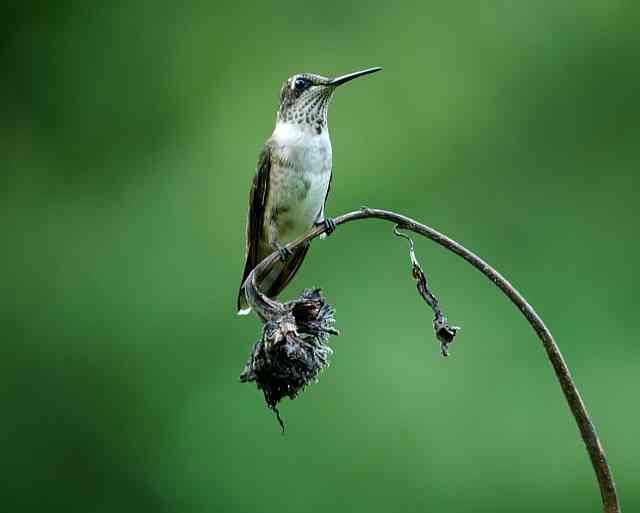
The short answer is you can take your feeders down in October. However, my real answer is – leave them up all year around ! Either because of climatological changes, or because we’re paying more attention, hummingbirds that normally stay in the western part of the U.S. are showing up in the winter in the east, especially along the gulf coast. I had no idea this was true until the winter of 05-06, and I hosted 5 birds in my yard that year. In 06-07, that number was at least 8, and at least one of the birds was a Ruby-throat that decided to stay over. See the section “How do I attract winter hummingbirds” below for more information.
What about plants? Which plants do hummingbirds prefer?
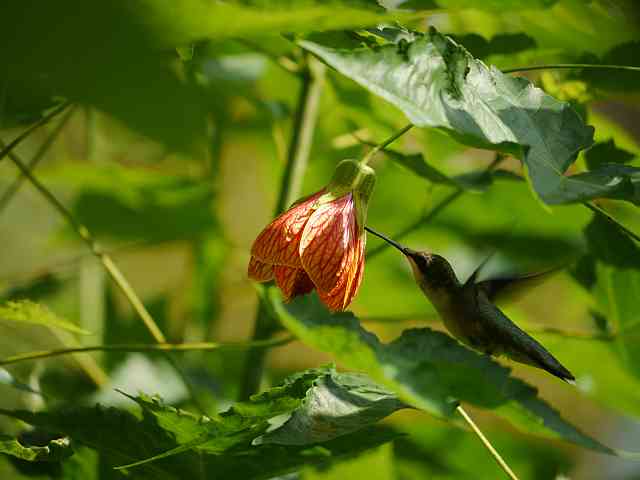
Hummingbirds love flowers that produce a lot of nectar. Here is a list of plants that are proven to be nectar-rich. Most are sensitive to cold so will need to be protected if the temperature dips below freezing. They may freeze back, but most rebound from the roots quite nicely. Most of these plants prefer some protection from full sun, doing quite well as understory plants under tall trees.
Red Abutilon (Abutilon pictum)
Abutilon "Little Imp" (Abutilon megapotamicum)
Parlor Maple or Flowering Maple (Abutilon pictum)
Bottlebrush (Callistemon citrinus)
Bottlebrush Buckeye (Aesculus parviflora)
Red Buckeye (Aesculus pavia) *native
Canna (sp.)
Cape Honeysuckle (Tecomaria capensis)
Cardinal Flower (Lobelia cardinalis) *native
Copper Iris (Iris fulva) *native
Coral Bean or Mamou (Erythrina herbacea) *native
Coral Honeysuckle (Lonicera sempervirens) *native
Cross Vine (Bignonia carpreolata) *native
Cry-Baby Tree (Erythrina crista-galli)
Cypress Vine (Ipomoea quamoclit)
Firebush (Hamelia patens)
Fire Spike (Odontonema strictum)
Firecracker Vine (Manettia cordifolid)
Fountain Plant (Russelia equisetiformis)
Ginger (Hedychium sp.) Japanese Flowering
Cherry (Prunus serrulata "Kwansan")
Java Plant (Clerodendrum speciossissimum)
Mimosa (Albizziajulibrissiri)
Mexican Cigar (Cuphea ignea "David Verity")
Winter or Giant Mexican Cigar (Cuphea micropetala)
Pagoda Plant (Clerodendrum paniculatum)
Scarlet sage (Salvia coccinea) *native
Salvia “Van Houttei (Salvia splendens "Van Houttei")
Anise Sage (Salvia guaranitica “Black and Blue”)
Pineapple Sage (Salvia elegans)
Autumn Sage (Salvia greggii)
Salvia "Indigo Spires" (S. farinacea x S. longispicata)
Salvia "Argentine Skies" (var. S. guaranitica)
Salvia "Purple Majesty" (var. S. guaranitica)
Salvia "Waverly" (var. S. leucantha')
Trumpet Vine (Campsis radicans) *native
Turk's Cap or Sultan's Turban {Malvaviscus arboreus "Drummondii") *native
Vervain or Porterweed (Stachytarpheta jamaicensis)
Winter Honeysuckle (Lonicera fragantissima)
Winter “ugly” Shrimp (Justicia brandegeana)
What are "winter" hummingbirds?
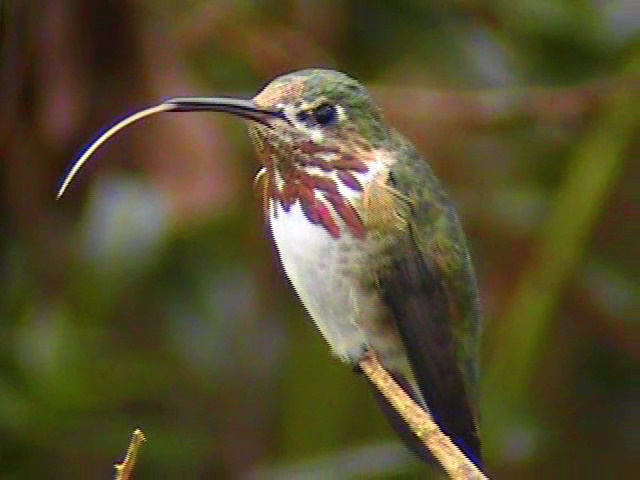
Winter hummingbirds are, in a nutshell, hummingbirds that don't "belong" here. They are generally western species of hummingbirds that, for unknown reasons, choose to spend the winter along the gulf coast rather than departing for their standard wintering grounds in Mexico and Central America. Species such as Rufous, Anna's, Allen's, Buff-bellied, Calliope, Black-chinned, Broad-tailed, and Broad-billed Hummingbirds have all been found within Louisiana's borders in the off-season (note that we call them "winter" birds but some may arrive as early as August!).
The birds will generally pick a winter territory and stay through February or March and then take off across the continent. Louisiana hummingbird birders and bird-banders have been tracking these birds for several years. If you see a hummingbird in your yard between November and February, it's very likely one of these western vagrants. Please report it so that we can keep track of it -- we want to better understand the migration patterns of these amazing birds. Send an email to BR Audubon to report a bird.
Here's a link to a program about Winter Hummingbirds in Louisiana
How do I attract winter hummingbirds?
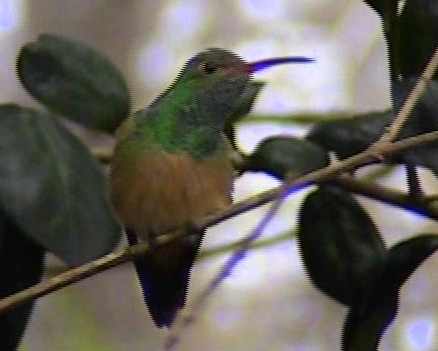
There are a few things you need to attract winter hummers to your yard. First, attract other birds to your yard. If other birds are there, it seems to be more likely you’ll have hummers. They need cover, so if you have evergreens like camellias, sweet olive, ligustrum, and hollies, they’ll like that. Hang a few feeders of course, but also provide some winter flowers, such as winter-flowering shrimp plant, cuphea, russelia, firespike, and abutilon.
Study up on western hummers. The most common of these uncommon birds is the Rufous. Rufous are very similar to Allen’s however, so until a bander captures a bird and tells them apart, we generally refer to any rusty-colored hummer as Rufous/Allen’s. Next most common is the Black-chinned hummer and than the Buff-bellied Hummingbird, which is almost twice as big as a Ruby-throated Hummingbird and has an acid green throat! Broad-tailed hummers are occasionally found. Broad-tailed males are distinctive in their gorget color, but Broad-tailed females look very similar to female Rufous/Allen’s.
The Calliope hummer is the smallest of the North-American hummingbirds and they seem to be showing up in increasing numbers. There have also been reports of Broad-billed, Anna’s, and the exceedingly rare Blue-Throated and Magnificent. If you live east of the Mississippi and see any hummers between November and February, report them! Someone will want to know, and they may even want to come to your house and band the birds so they can understand more about where they travel when they migrate.
